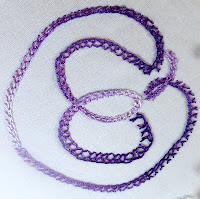This week we were assigned the Oyster stitch. Despite the
good instructions on Sharon’s website and the great video on Mary Corbet’s website I couldn’t get the hang of it. I tried all the normal tricks for left
handed people like flipping the pictures or turning my laptop upside down but
it just wasn’t working. I don’t remember how many times I ripped out my
stitches and started again. Finally I took a long hard look at the pictures and
started again. I decided that maybe I was going in the wrong direction so I
switched the way I was working my scribble. Then I realized my twist wasn’t
correct. It was twisted but the starting thread was on top and in looking at
the pictures it should have been underneath the second leg of the chain. Of
course I wasn’t trying to do single stitches either, I wanted to continue with
my scribbles and so I needed to do it as a chain.
I finally got the hang of it and after doing quite a few of
them I decided to take pictures of my steps. I’m sharing them here just in case
there is another lefthander that is still struggling with this stitch. I really
like the way it came out although they aren’t all perfect. But perfect is overrated
right?
Click on any photo to enlarge it for more detail.
Step one:
Bring the thread to the front of your work. If you are working
a continuous line you only need to do this at the start and when you have to
end a thread and start a new one. The only time you anchor the last step with a
small stitch is to end a thread or when you have finished the line.
Step two:
 |
| Starting the twisted chain |
Make the twisted chain. Place the needle a little to the
left and down a thread or two from the starting thread. Bring it back up a
short distance on your line. This will depend on how long you want the stitch
to be.
 |
| Wrap the thread over and under the needle |
With the thread to the right of the needle wrap the thread over and
under the needle. Pull the needle through the fabric.
 |
| Before tightening the stitch |
 |
| Twisted chain stitch |
This should be a twisted
chain. Be sure the thread from the beginning of the stitch is underneath.
Step three:
 |
| Going under the starting thread |
Now bring your needle up to and under the beginning thread. Do
not go through the fabric. Check the direction of this stitch, the loop should
be on the right of the stitches.
 |
| Step four |
Next take the needle down into the fabric inside the loop
still keeping to the right of the stitches and near the starting point. Bring
the needle back out at the bottom of the stitches but not inside the loop.
 |
| Thread is now on the left of needle |
The thread in the needle should now be on the left of the
stitches, you can tighten the loop some but not too much.
Step five:
Loop the thread under the needle and pull the needle through
to finish the stitch. If needed give the stitch a little tightening. Be sure
not to pull it too tight.
 |
| Thread is looped under the needle |
 |
| Finished stitch! |
You are now ready to start the next stitch. If you are doing a line go to step two. If you want a single stitch anchor the last loop with a small stitch.
If this has helped you with this stitch I'd love to hear about it so leave me a comment!
Happy Stitching!


















